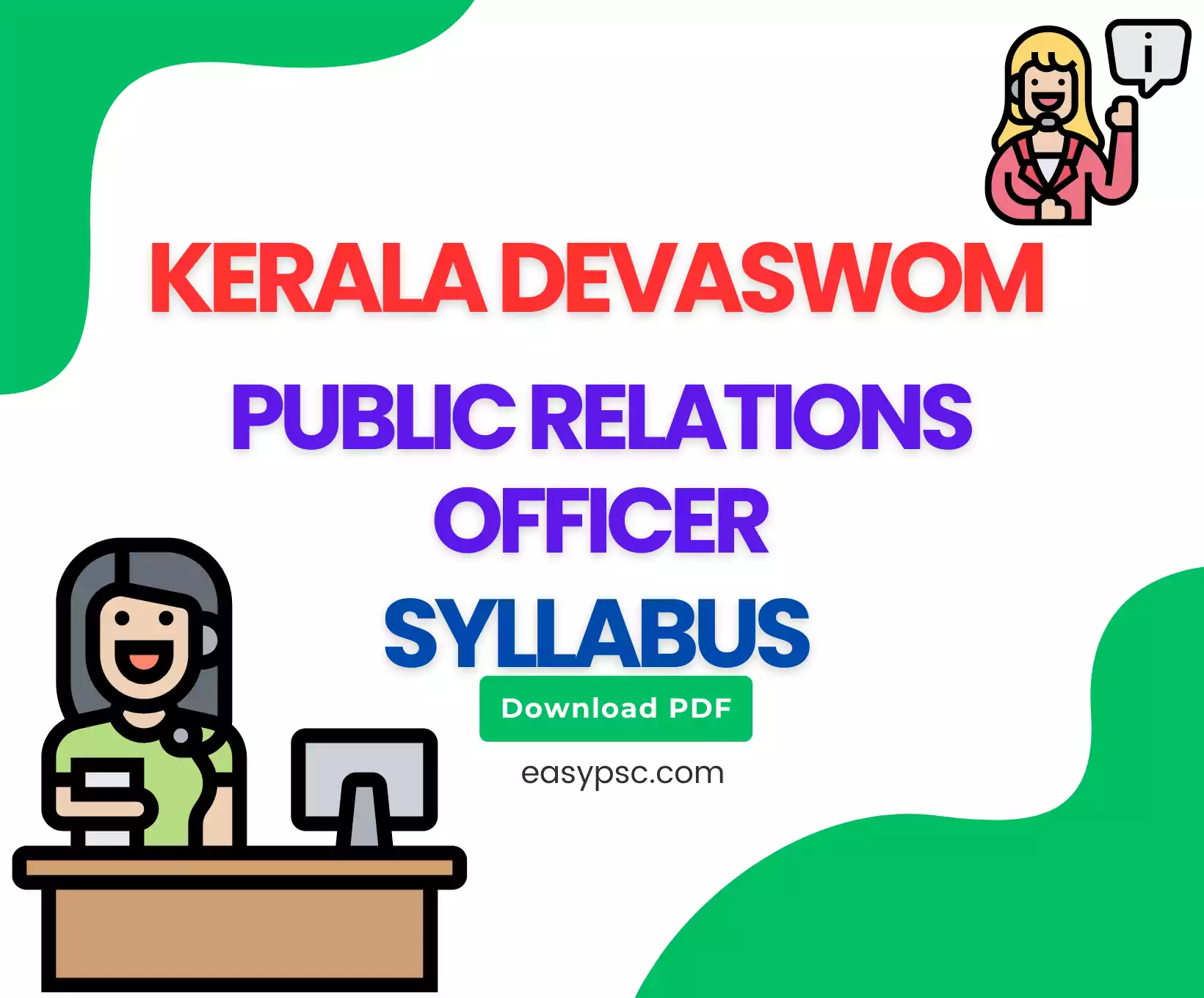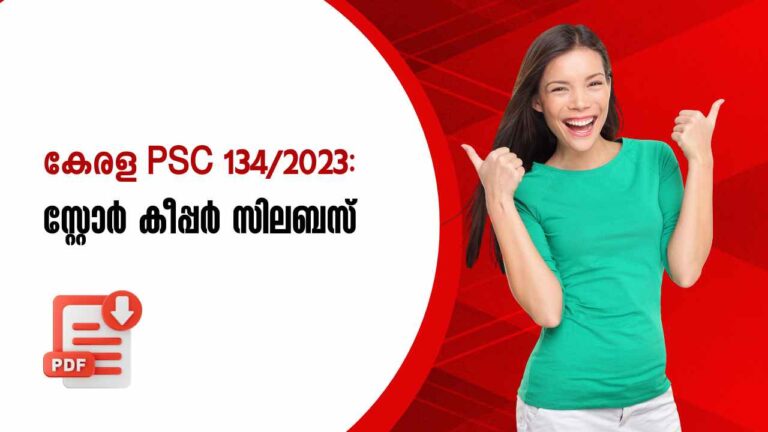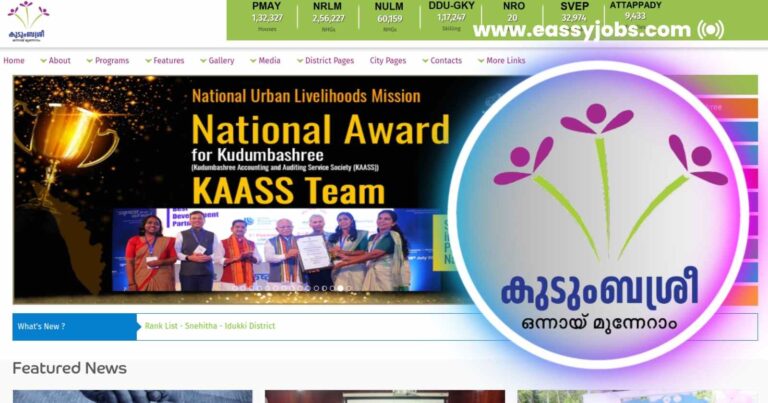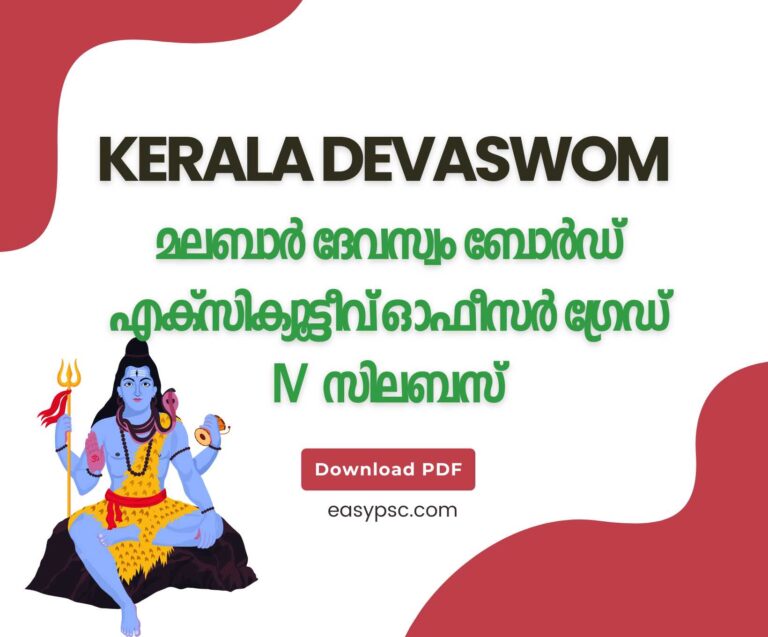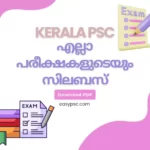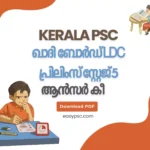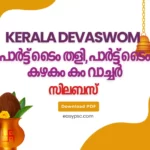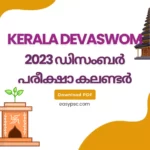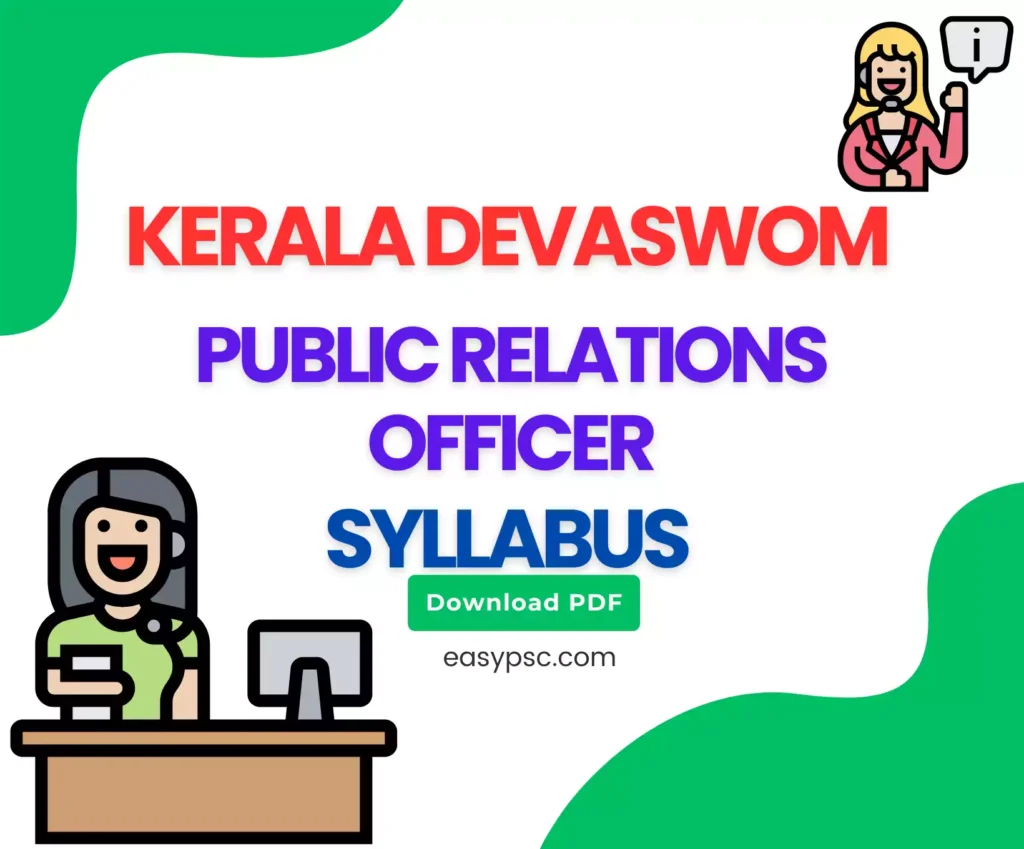
കേരള ദേവസ്വം പബ്ലിക്ക് റിലേഷൻസ് ഓഫീസർ സിലബസ് – ഡൗൺലോഡ് PDF: കേരള ദേവസ്വം ബോർഡ് 2024 ഫെബ്രുവരി 18 ന് നടത്തുന്ന തിരുവിതാംകൂർ ദേവസ്വം ബോർഡിലേക്കുള്ള പബ്ലിക്ക് റിലേഷൻസ് ഓഫീസർ പരീക്ഷയുടെ വിശദമായ സിലബസും പരീക്ഷാ പാറ്റേണും ഇവിടെ നിന്നും PDF രൂപത്തിൽ ഡൗൺലോഡ് ചെയ്യാം. 18-02-2024 ഞായറാഴ്ച 10:00 മുതൽ 12:30 വരെയാണ് പരീക്ഷ നടക്കുന്നത്. 100 മാർക്കിന്റെ വിവരണാത്മക പരീക്ഷയാണ് വരുന്നത്. 2 മണിക്കൂറാണ് പരീക്ഷാ സമയം. ഇംഗ്ലീഷ് ഭാഷയിലായിരിക്കും ചോദ്യ പേപ്പർ ലഭിക്കുക. 03-02-2024 മുതൽ അഡ്മിഷൻ ടിക്കറ്റ് കേരള ദേവസ്വം റിക്രൂട്ട്മെന്റ് ബോർഡിന്റെ ഔദ്യോഗിക വെബ്സൈറ്റായ www.kdrb.kerala.gov.in ലൂടെ ഒറ്റത്തവണ രജിസ്ട്രേഷൻ പ്രൊഫൈൽ വഴി ഡൗൺലോഡ് ചെയ്യുവാൻ സാധിക്കും
പ്രധാന വിവരങ്ങൾ
താഴെ കൊടുത്തിരിക്കുന്ന പട്ടികയിൽ നിന്നും കേരള ദേവസ്വം ബോർഡ് പബ്ലിക്ക് റിലേഷൻസ് ഓഫീസർ തസ്തികയിലേക്കുള്ള പരീക്ഷകളുടെ സിലബസിന്റെ എല്ലാ പ്രധാനപ്പെട്ട വിവരങ്ങളും ലഭിക്കുന്നതാണ്.
| പരീക്ഷ നടത്തുന്ന ഓർഗനൈസേഷൻ | കേരള ദേവസ്വം റിക്രൂട്ട്മെന്റ് ബോർഡ് |
| കാറ്റഗറി | സിലബസ് |
| തസ്തികയുടെ പേര് | പബ്ലിക്ക് റിലേഷൻസ് ഓഫീസർ (Public Relations Officer) |
| കാറ്റഗറി നമ്പർ | 11/2023 |
| ദേവസ്വം | തിരുവിതാംകൂർ ദേവസ്വം |
| വിദ്യാഭ്യാസ യോഗ്യത | ബിരുദം പബ്ലിക്ക് റിലേഷൻസ് / ജേണലിസത്തിൽ പി.ജി. ഡിപ്ലോമ അല്ലെങ്കിൽ തത്തുല്യ യോഗ്യത |
| പരീക്ഷാ രീതി | നിശ്ചിത വിദ്യാഭ്യാസ യോഗ്യതയെ അടിസ്ഥാനമാക്കിയുള്ള വിവരണാത്മക പരീക്ഷ (Descriptive Test based on the qualifications prescribed for the post) |
| ചോദ്യ ഭാഷ | ഇംഗ്ലീഷ് |
| ആകെ ചോദ്യങ്ങൾ | |
| ആകെ മാർക്ക് | 100 |
| പരീക്ഷാ സമയം | 2 മണിക്കൂർ |
ദേവസ്വം ബോർഡ് മുൻവർഷ ചോദ്യപേപ്പറുകൾ
കേരള ദേവസ്വം റിക്രൂട്ട്മെന്റ് മുൻവർഷങ്ങളിൽ നടത്തിയ പരീക്ഷകളുടെ ചോദ്യങ്ങളും ഉത്തരങ്ങളും അടങ്ങിയ PDF തയ്യാറാക്കിയിട്ടുണ്ട്. 2006 മുതൽ 2023 വരെ KDRB നടത്തിയ പരീക്ഷകളുടെ ചോദ്യ പേപ്പറുകൾ ആണ് ഈ PDF ൽ അടങ്ങിയിരിക്കുന്നത്. കൂടാതെ സ്പെഷ്യൽ ടോപ്പിക്സിൽ വരുന്ന പ്രധാനപ്പെട്ട ചോദ്യങ്ങളും ഉത്തരങ്ങളും ആഡ് ചെയ്തിരിക്കുന്നു. ഡെമോ ലഭിക്കാനും മുഴുവൻ PDF വാങ്ങാനുമായി താഴെ കാണുന്ന ലിങ്കിൽ ക്ലിക്ക് ചെയ്യുക.
| പാർട്ട് I | |
| (1) | മലയാളത്തിൽ നിന്നും ഇംഗ്ലീഷിലേക്കുള്ള വിവർത്തനം |
| (2) | ഇംഗ്ലീഷിൽ നിന്നും മലയാളത്തിലേക്കുള്ള വിവർത്തനം |
| (3) | പത്രക്കുറിപ്പ് തയ്യാറാക്കൽ |
| പാർട്ട് II | |
| (1) | പബ്ലിക്ക് റിലേഷൻസ് വിഷയങ്ങൾ |
| പാർട്ട് III | |
| (1) | ക്ഷേത്രകാര്യങ്ങൾ, ഹൈന്ദവ സംസ്കാരം, ആചാരാനുഷ്ഠാനങ്ങൾ, വിവിധ ദേവസ്വങ്ങൾ എന്നിവ |
വിശദമായ സിലബസ്
തിരുവിതാംകൂർ ദേവസ്വത്തിൽ പബ്ലിക്ക് റിലേഷൻസ് ഓഫീസർ പരീക്ഷയുടെ വിശദമായ സിലബസ് താഴെ നിങ്ങൾക്ക് കാണാവുന്നതാണ്. ഓരോ വിഷയങ്ങളും ഏത് ഭാഗത്ത് നിന്നും വരുന്നു എന്ന് കണ്ടെത്തി ചിട്ടയായ ഒരു പഠന രീതി ഉണ്ടാക്കിയെടുക്കുക. സിലബസും എക്സാമിന് ബാക്കിയുള്ള സമയവും വെച്ച് കൃത്യമായ ഒരു സ്റ്റഡി പ്ലാനും ടൈം ടേബിളും ഉണ്ടാക്കിയെടുക്കുക. കൃത്യമായി പഠിക്കുക. റാങ്ക് ലിസ്റ്റിൽ ഉയർന്ന ഒരു റാങ്ക് തന്നെ കരസ്ഥമാക്കുക. ഉടനെ ഒരു സർക്കാർ ജോലി എന്ന നിങ്ങളുടെ സ്വപ്നം നിറവേറ്റുക.
പ്രധാന വിഷയങ്ങളെ അടിസ്ഥാനമാക്കിയുള്ള വിശദമായ സിലബസ്
Public Relations
Communication process, Models and Theorie
Communication process – Definitions – Elements – Nature and scope – Various scholarships and approaches – Levels of communications – Intrapersonal, Interpersonal, Group, Mass etc. – Models of communication: Aristotle – Laswell, Shannon and Weaver – Schramm and Osgood – George Gerbner – Riley and Riley – Maletzke – Elihu Katz and Paul Lazarsfeld – Elisabeth Noelle-Neumann – Walter Gieber and Walter Johnson – David Manning White – McNelly’s model Galtung and Ruge – Diffusion of Innovation Model – One step, Two step, Multi step flow of Communication – Mowlana’s model of International Flow of Information – Uses and Gratification Approach – Semantic space theory – Cognitive theories – Behavioral theories – Stimulus Response Theory – Hypodermic Needle theory – Limited effect model Communication theories – Selective Exposure, Perception and Retention – Balance Theory – Congruity Theory – Social Learning Theory – Individual Differences Theory – Social Differentiation Theory – Social Relationship Theory – Concept of mass – Mass Society Theory – Agenda Setting Theory, Framing, Priming, Stereotyping, Ideas of Persuasion, Propaganda – Cognitive Dissonance Theory Obstinate Audience Theory – Social Judgment/Involvement theory – Social Learning Theory – Media Ecology – Normative Theories of the Press – Effects and Impact studies in Communication – Media Dependency Theory – Phenomenological methods in Communication – Transitions in Media usage patterns – Issues of Form and Content – Empirical points of differences – Social Media environment – Role of Information and Data of contemporary period – Post Modernism and Media – Communication Accommodation – Convergence – Divergence and Over Communication.
Writing for Print Media
Print Journalism – Characteristics of print media – Print media evolution – Historical perspective on print journalism – Types of print media – Concept of News – Definition of News – News Literacy – News values – Elements of news – Photo Journalism – Formats of news Presentation – News story structure – Inverted pyramid style – Hourglass – Narrative style – Follow ups – Types of news – Hard news – Soft news – Human interest etc. – Feature story types and approaches – Developing feature story ideas – Profile writing – Narrative storytelling in features – Technology and news gathering and dissemination – Hybrid media – Objectivity – Source cultivation – Interviewing skills – Types of news interviews – Beats – Types of reporting – Political– Science & Technology – Development– Court – Travel and tourism – Arts and Culture – Investigative, Interpretative, Embedded, In-depth, Cheque book, Yellow, Aggressive, Campaign – News Agencies – Press Releases, Meet the press, Press Conferences, Government and non-Government sources, crowd sourcing, citizen reporting, social media sources – credibility and authenticity – Hierarchies in news organizations – Deadlilnes – Trends in Automated Reporting – Natural language generation – Writing for Niche audience – Data-driven reporting – Real-time reporting – Automated fact checking – Artificial Intelligence enhanced interviews – Content Monetization – News algorithm – Fake news – Deepfake – Principles of Editing – Stylebook and guidelines – Editing for clarity and conciseness – Multi-media storytelling – Headline writing, Modern Trends Checking Facts And Figures, Accuracy, Fairness and Objectivity – Localising News, Subbing, Rewriting – Editorial writing – Page design – Principles of Layout and colour – Typography – Photo editing – Caption writing.
Public Relations and Corporate Communication
Publicity – Propaganda – Public Relations – Definitions – Public Relations in Popular Culture – Growth of Public Relations – The History of Modern Public Relations – Pioneers of Modern Public Relations – Public Relations Agency – Roles and Functions for Public Relations – Strategic communication, Marketing Communications, Crisis Management, Research and Strategic Planning etc. – Public Relations Tool Kit – Integration of Public Relations and Marketing – Globalization and PR practices – Ethics and Laws in Public Relations – PR for Public Good – Characteristics of a PR practitioner – The PR Practitioner as gatekeeper – Organisational communication – Internal and External communication – PR campaigns – Professional organizations – Professional standards and Code of ethics – Principles of Influence – Management Models – The Four models of Grunig and Hunt –The press agentry/ publicity model, The public Information model – The two-way asymmetric model – The two –way symmetric model – Excellence Theory – Image Restoration Theory – Structuring a PR programme – RACE, SWOT and PEST analyses – ROPES model – Public Relations Writing Strategy and Style – Media Relations in a Digital World – Media Relations in Political Communications – Media Relations in Crisis Situations – Government PR – Information and Public Relations Department of Kerala – Social Media and Emerging Technologies in PR – Social Network Theory – Gamification – Corporate Communication – Corporate Identity – Corporate reputation/ image – Integrated Communication – Stakeholder Communication – Campaign Management – Corporate Social Responsibility – Community Relations -Employee Relations – Corporate Culture.
Advertising
Idea of Persuasion – Persuasive Communication – Definition of Advertising – Evolution of advertising – Advertising archeology – Advertising pots, Early Years – The Dark Age – Industrial revolution and advertising – Advertising and war years – Post-world war period advertising – Advertising in the digital age – Types of advertising – Functions of branding – Brand name nomenclature – Creative Elements of advertising – Headlines, Body copy, logo, slogans – taglines – jingles – Copy writing process – Copy writing Techniques – USP – Advertising appeals Layout and Design, Visualization – Engaging the advertising message – Advertising campaign – Planning, Evaluation of advertising campaigns – Advertising Agency – Types of advertising agencies – Structure and functions – Media planning – Advertising Theories, DAGMAR – David Ogilvy and Rosser Reaves theories – Means–end chain – AIDA formula – Consumer Learning Theory – Hierarchy of Effects Models- Elaboration Likelihood Model of Attitudinal Change (ELM) – Source credibility theory – Congruency theory – Schema theory – Involvement theory – Advertising Media: Traditional: Print, Radio, Television, Outdoor, Transit etc. – Digital and Emerging Media: Digital media devices – The digital media platform – Browsers – Social media platforms – E-mails – Pop-ups – Overlays – In-text adverts – Computational Advertising – Native adverts – Paid search – In-App advertisements – In-games advertisements – Static in-game advertising (SIGA) – Dynamic in-game advertising (DIGA) – On-games – Advergaming – Emerging technologies: Location-based advertising, Online behavioural advertising, Augmented and virtual reality (AVR), Near-field communication (NFC) – Advantages of digital media advertising – Limitations of digital media – Trends in Indian Advertising, ASCI, Advertising Research- Scope and objectives – Marketing Communication – Concept, Nature, Functions and Importance – Market segmentation – Target market selection – Market positioning – Product Life Cycle – Advertising as a Marketing Tool – The Marketing Mix – Integrated Marketing communication – marketing survey
Reporting
News – Concepts, elements, values. Sources of News, Techniques of news gathering and dissemination. News flow, Predictable & Unpredictable News, Soft news and Hard news, anticipated news, follow-ups, slanting/advocacy. News Story – Structure of news, story inverted pyramid, and other styles. Principles of News Writing – Intro, body, backgrounding, conclusions, and their variations, different kinds of lead, changing styles of news writing. Reporting speeches, seminars, conferences, press conferences, meet the press, briefings, demonstrations, rallies, agitations, press releases, court proceedings, legislature, and parliament. Reporter – Qualities and Functions, social responsibility. Types of Correspondents, Development news, science & technical news, election news, accidents, death, crime, war disasters, conflicts, obituaries, weather, and human interest stories. Cultural Reporting, Art of interviewing, techniques, and strategies for interviews. Types of interviews – investigative, interpretative, embedded, in-depth, cheque-book, Page Three & Local Page, aggressive, yellow, paparazzi, tabloid, intimate, public service, laid-back, citizen journalism, and planting stories
Temple Affairs – Hindu Culture, Customs, and Traditions – Various Devaswom Boards, etc
Temple Affairs. Famous Temples in Kerala – Deities, Peculiarities, Location. Temple Festivals. Special ceremonial and devotional functions in temples – Its importance and Social relevance. Temple Arts. Famous Temple Artists. Temple Architecture in Kerala – Its peculiarities and ethnic importance. Great Spiritual Leaders, Saints, Thinkers, and Philosophers in Hinduism – Their contributions. Holy books of Hinduism – Vedas, Puranas, and Upanishads – Basic knowledge. Concept of Devaswoms. History of temples in Kerala. Events that lead to the formation of Devaswoms. Temple Entry Proclamation. Travancore-Cochin Hindu Religious Institutions Act 1950. Present-day Administration of Temples in Kerala and Various Devaswom Boards. Kerala Devaswom Recruitment Board – Formation, powers and responsibilities – Hierarchial setup.
PDF ഡൗൺലോഡ് ചെയ്യാം
കേരള ദേവസ്വം റിക്രൂട്ട്മെന്റ് ബോർഡ് തിരുവിതാംകൂർ ദേവസ്വത്തിൽ പബ്ലിക്ക് റിലേഷൻസ് ഓഫീസർ പരീക്ഷയുടെ വിശദമായ സിലബസ് ഔദ്യോഗിക വെബ്സൈറ്റിൽ പ്രസിദ്ധീകരിച്ചു. താഴെ കൊടുത്തിരിക്കുന്ന ലിങ്കിൽ നിന്നും തിരുവിതാംകൂർ ദേവസ്വത്തിൽ പബ്ലിക്ക് റിലേഷൻസ് ഓഫീസർ പരീക്ഷയുടെ സിലബസ് PDF ഡൗൺലോഡ് ചെയ്ത് എടുക്കാം.
